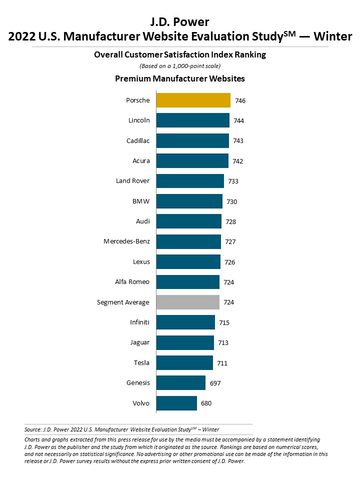It is indisputable that the internet has become increasingly impactful in consumers’ decisions throughout the past decade, especially the past two years as shopping online has boomed due to the pandemic. Car buyers have begun to rely more heavily on manufacturers’ and dealers’ websites to get vital information to use when deciding on which car to purchase, so these entities should do whatever they can to make sure their websites are more than satisfactory.
OEM Website Satisfaction Drops
A recent J.D. Power study conducted in October and November of 2021 showed that consumers’ satisfaction with manufacturers’ websites is below par, with overall satisfaction for the premium segment being an average of 724 out of 1,000 and overall satisfaction for the mass market segment being 711 out of 1,000. In the premium segment, Porsche fared the best with an average satisfaction score of 746, while Volvo ended up last with a score of 680. In the mass market segment, Subaru topped the list with a score of 733 and MINI ended up last with a score of 680.
According to J.D. Power, its U.S. Manufacturer Website Evaluation Study SM (MWES) is conducted twice a year and “examines the features and content of OEM-hosted websites across all devices that shoppers find useful and engaging when shopping online for a new vehicle.” It analyzes specifically what car buyers are focusing on when looking at a manufacturers’ website, which includes “content, appearance, navigation, and speed.”
Perhaps one of the most notable findings of the study was that 53% of OEM websites experienced a dip in website satisfaction in regard to vehicle finder features, meaning consumers found the websites less helpful when trying to decide which vehicles might be right for them. The results of the study should send a message to automakers that they may want to invest more time and resources into improving their websites to increase customer satisfaction.


What Dealers Can Do with This Information
So, what can dealers learn from this? For starters, it strongly emphasizes just how important their websites are and how they make a significant impact on their current and potential customers. In general, most people admit to quickly exiting “ugly” and hard-to-use websites, so dealers want to avoid getting that response from people by implementing websites with better aesthetics and easy-to-use functionalities. Having a slow website is also a great way to lose customers, so dealers should also make sure their websites’ speeds are sufficient.
J.D. Power’s digital solutions director Jon Sundberg said that another thing OEMs can do to improve customer satisfaction “despite things that are out of the manufacturers’ digital control, like inventory issues” is to offer things like waitlists. Seeing as dealers have also been heavily impacted by parts and supply shortages for the past 22 months, they could also benefit from doing so. Offering waitlists for the specific vehicles customers want can assure them they will get the vehicle they are looking for once it hits the lot despite it not being available right away.
| Related: GM gets on California OEM list by recognizing state emissions regulations |
Most dealer websites have some form of vehicle finder feature and seeing as J.D. Power’s study showed a significant drop in satisfaction regarding these, dealers should take note and take measures to increase the ease and reliability of such functions as well as offer enough filters on them so customers can adjust them to find exactly what they want. For example, as time goes on and more electric vehicles (EVs) hit the market, dealers may want to have filters that will separate these vehicles from gas-powered ones so customers can seamlessly find what type of car they are looking for.
These days, it is becoming increasingly important for websites to be both desktop-friendly as well as smartphone- and tablet-friendly. Many people utilize their phones or tablets most of the time now, so dealers should make sure their websites are integrated to accommodate whatever devices they are being accessed from. Ultimately, J.D. Power’s study may indicate that dealers who make their websites more attractive and more easily accessible may have a better chance of making sales and retaining customers
Did you enjoy this article from Kimberly Hurley? Read other articles on CBT News here. Please share your thoughts, comments, or questions regarding this topic by submitting a letter to the editor here, or connect with us at newsroom@cbtnews.com.
Be sure to follow us on Facebook and Twitter to stay up to date or catch-up on all of our podcasts on demand.
While you’re here, don’t forget to subscribe to our email newsletter for all the latest auto industry news from CBT News.











